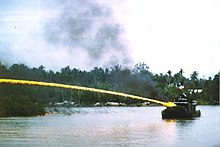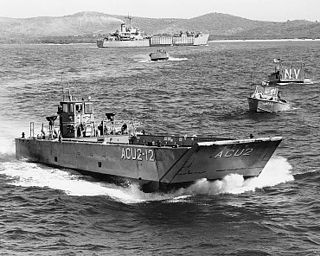
The LCM-8 is a river boat and mechanized landing craft used by the United States Navy and Army during the Vietnam War and subsequent operations. They are currently used by governments and private organizations throughout the world. The acronym stands for "Landing Craft Mechanized, Mark 8".

Patrol Boat, Riverine, or PBR, is the United States Navy designation for a small rigid-hulled patrol boat used in the Vietnam War from March 1966 until 1975. They were deployed in a force that grew to 250 boats, the most common craft in the River Patrol Force, Task Force 116, and were used to stop and search river traffic in areas such as the Mekong Delta, the Rung Sat Special Zone, the Saigon River and in I Corps, in the area assigned to Task Force Clearwater, in an attempt to disrupt weapons shipments. In this role they frequently became involved in firefights with enemy soldiers on boats and on the shore, were used to insert and extract Navy SEAL teams, and were employed by the United States Army's 458th Transportation Company, known as the 458th Sea Tigers. The PBR was replaced by the Special Operations Craft – Riverine (SOC-R)

Operation Sealords was a military operation that took place during the Vietnam War.

The term brown-water navy or riverine navy refers in its broadest sense to any naval force capable of military operations in littoral zone waters. The term originated in the United States Navy during the American Civil War, when it referred to Union forces patrolling the muddy Mississippi River, and has since been used to describe the small gunboats and patrol boats commonly used in rivers, along with the larger "mother ships" that supported them. These mother ships include converted World War II-era Landing Crafts and Tank Landing Ships, among other vessels.

The landing craft mechanized (LCM) is a landing craft designed for carrying vehicles. They came to prominence during the Second World War when they were used to land troops or tanks during Allied amphibious assaults.

Armored Troop Carriers (ATC), often called Tangos from the phonetic alphabet for T, were LCM-6 landing craft modified for riverine patrol missions. They were used by the Mobile Riverine Force (MRF) of the United States Army and Navy in the Vietnam War. They were also used by Republic of Vietnam Navy (RVNN) and Khmer National Navy.
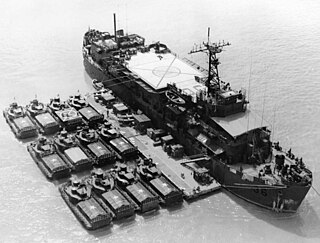
USS Colleton (APB-36), was a Benewah-class barracks ship. Colleton's keel was laid on 9 June 1945, launched on 30 July 1945 and delivered on 27 September 1946. She was berthed at Boston, Massachusetts in the custody of the United States Maritime Commission.
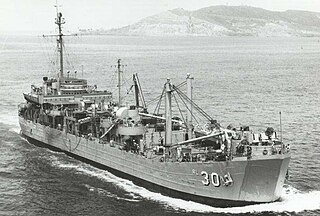
USS Askari (ARL-30) was one of 39 Achelous-class landing craft repair ships built for the United States Navy during World War II. Askari is an Arabic word for soldier, a term frequently applied to indigenous troops in Africa serving European colonial powers, particularly the British and Germans in East Africa from the late 19th century to the end of World War I; ARL-30 has been the only U.S. naval vessel to bear the name.

Operation Game Warden was a joint operation conducted by the United States Navy and South Vietnamese Navy in order to deny Viet Cong access to resources in the Mekong Delta. Game Warden and its counterpart Operation Market Time are considered to be two of the most successful U.S. Naval actions during the Vietnam War.

The Dinassaut was a type of riverine military unit employed by the French Navy during the first Indochina War. It's an example of Riverine artillery.

Operation Truong Cong Dinh, was a United States and Army of the Republic of Vietnam (ARVN) security operation to reestablish South Vietnamese control over the northern Mekong Delta in the aftermath of the Tet Offensive. The operation aimed to root out Viet Cong (VC) forces in the area, and to stop them from attacking traffic on the nearby Highway 4.
Operation Coronado II was the second of eleven in the Operation Coronado series conducted by the U.S. Mobile Riverine Force (MRF) in conjunction with various units of the Army of the Republic of Vietnam (ARVN) in late July 1967 in an attempt to shut down Viet Cong (VC) strongholds in the Mekong Delta. Three battalions of American troops, along with two ARVN battalions, backed by helicopters and watercraft swept the area and waterways surrounding Mỹ Tho in search of VC forces. Two VC battalions were encountered and many captured, although both sides suffered numerous casualties. The Allied forces also cordoned off the area to search water traffic for VC supplies or suspects. The Americans credited the South Vietnamese 3rd Marine Battalion for the success of the operation.
Operation Coronado IV was the fourth of the Operation Coronado series of riverine military operations conducted by the U.S. Mobile Riverine Force (MRF), designed to shut down Viet Cong (VC) strongholds in the Mekong Delta. It ran from 19 August to 9 September 1967. It took place in Long An, Gò Công and Kiến Hòa Provinces.
Operation Coronado V was a riverine military operation conducted by the U.S. Mobile Riverine Force (MRF) and elements of the Army of the Republic of Vietnam from 12 September to 5 October 1967 in an attempt to shut down Viet Cong (VC) strongholds in the Mekong Delta. The first part of the operation took place in Định Tường Province. After receiving intelligence that the VC 263rd Main Force battalion had been seen in the region, three Allied battalions were brought in on 12 September by helicopters and boats. Immediately there was heavy contact, and although the Allies reported killing 134, the majority of the VC escaped. Sweeps of the area resulted in another major confrontation with the VC on 15 September. During the four-day period, U.S. and ARVN reported 213 VC killed. The Allied forces then moved into adjoining Kiến Hòa Province. From 5–7 October another encounter with the VC 263rd Battalion resulted and the Allies reported 163 VC killed while losing seven.
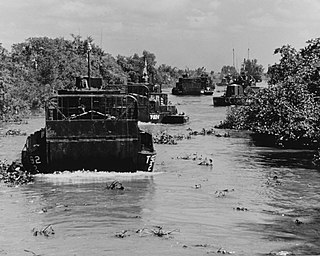
Operation Coronado IX was a riverine military operation conducted by the Mobile Riverine Force (MRF) of the United States and elements of the Army of the Republic of Vietnam (ARVN) from November 1967 to January 1968 in an attempt to destroy Viet Cong (VC) strongholds in the Mekong Delta. In the middle of November, clashes resulted in the capture of VC supplies and hideouts. During this period, the VC lost 178 men but killed only 26. For the next few weeks there was little contact, although some abandoned VC bunkers were destroyed and supplies captured. On 4 December, a large engagement occurred when a VC battalion encountered the South Vietnamese 5th Marine Battalion. 266 VC were killed, mostly by the Marines. The Marines lost 40 killed, while the Americans suffered 9 dead. Over the next month and the Christmas period, there was only sporadic skirmishes, but at the start of the new year, there were some medium size battles in which the Americans killed a few dozen VC. After this there was little contact.
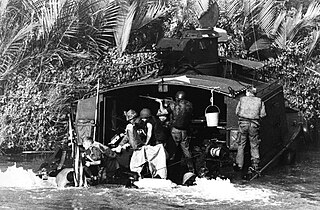
Operation Coronado XI was the eleventh of the Operation Coronado series of riverine military operations conducted by the U.S. Mobile Riverine Force (MRF) and units of the Army of the Republic of Vietnam (ARVN), designed to secure Cần Thơ in the aftermath of the Tet Offensive. It ran from 12 February to 3 March 1968.

The Khmer National Navy was the naval component of the Khmer National Armed Forces (FANK), the official military of the Khmer Republic during the Cambodian Civil War between 1970 and 1975.
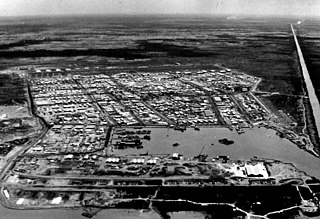
Đồng Tâm Base Camp is a former U.S. Army, U.S. Navy, and Army of the Republic of Vietnam (ARVN) base west of Mỹ Tho in the Mekong Delta, southern Vietnam.
Operation Coronado X was the tenth of the Operation Coronado series of riverine military operations conducted by the U.S. Mobile Riverine Force (MRF) and units of the Army of the Republic of Vietnam (ARVN), originally planned as a sweep of western Dinh Tuong Province and eastern Kien Phong Province, however with the outbreak of the Tet Offensive on 31 January 1968 it instead became the MRF reaction to eject Vietcong (VC) forces from Mỹ Tho and Vĩnh Long. It ran from 23 January to 12 February 1968 and resulted in 269 VC killed for the loss of 12 U.S. killed.
The Battle of Bến Tre took place during the Tet Offensive of the Vietnam War when Vietcong (VC) forces attacked Bến Tre, the capital of Kien Hoa Province, on 31 January 1968. The battle lasted until 5 February when U.S. and South Vietnamese forces ejected the VC who suffered 328 killed. The extensive destruction to the city caused by the fighting led a U.S. officer to state that "It became necessary to destroy the town to save it."
